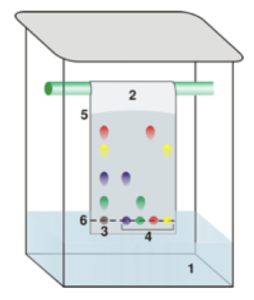Paper Chromatography (GCSE Chemistry)
Paper Chromatography
Paper Chromatography
Paper Chromatography is used to separate mixtures of soluble substances in a solution. Paper chromatography works on the principle that some substances are more soluble than others in a solvent. This is used to separate food colourings, inks and dyes.

Practice Question
Question: Sam has a mixture in a beaker, containing:
- Sand
- Salt
- Liquid A
- Liquid B
- Liquid C
Liquid A, B and C have boiling points of 72°C, 89°C and 120°C.
Salt is soluble in the mixture of liquids.
Sand is insoluble in the mixture of liquids.
Sam would like to collect samples of sand and Liquid B. How should he go about this?
For this question, we need to use multiple separation techniques.
Firstly, we need to consider our starting beaker. It contains a mixture of three liquids with salt dissolved (soluble), and sand collecting at the bottom (insoluble). Therefore, first we use filtration to collect the sand, whilst the salt solution passes through.
Secondly, we are left with a salt solution. If we wanted to collect just the salt, we could use crystallisation to remove the three liquid solvents. However, the question says that Sam wants to collect Liquid B. Therefore we can use fractional distillation, because the liquids have different boiling points.
We heat the solution, and Liquid A will be discarded first. We can keep the temperature at 72°C until all of Liquid A has been collected. It is important not to allow the temperature to rise anymore, because then Liquid B will start to collect too. Next, we discard Liquid A, and raise the temperature to 89°C, after which we collect Liquid B.
We are left with sand in the filter funnel, and a beaker of Liquid B. The salt remains dissolved in Liquid C in the round-bottomed flask, whilst Liquid A has been discarded.





Still got a question? Leave a comment
Leave a comment